-
 Kitagawa Utamaro. Illustration from the book Ehon koi no Onamaki. Cited at Hayashi Yoshikazu's 20-volume set Edo makura-e shi shusei: Kitagawa Utamaro. Size: Chuban (25.5 x 18.5 cm), two book pages glued together.
Kitagawa Utamaro. Illustration from the book Ehon koi no Onamaki. Cited at Hayashi Yoshikazu's 20-volume set Edo makura-e shi shusei: Kitagawa Utamaro. Size: Chuban (25.5 x 18.5 cm), two book pages glued together. -
 Artist: Kitagawa Utamaro [喜多川 歌麿] (Japanese, c. 1753 – 1806) "This uncommon half-size horizontal ōban ... is most likely one design from a set of twelve prints issued late in Utamaro's life" [Japanese Erotic Fantasies, Hotei Publishing, 2005, p. 143, pl. 47]. Half-size horizontal ōban must be 12.7 x 38 cm. Richard Waldman and Chris Uhlenbeck say it's tanzaku size (13 x 43 cm). In reality, the prints of this series measure 17 x 38 cm, which corresponds exactly to horizontal o-hosoban paper size. I managed to assemble 11 of allegedly 12 designs. 7 of them have genitals colored by hand. It's hard to tell whether it was done by the publisher on demand of a peculiar buyer, or by the owner of the prints who considered the black and white privy parts unnatural. My sequencing of the prints is arbitrary. Transcription of the text may help find the correct order.
Artist: Kitagawa Utamaro [喜多川 歌麿] (Japanese, c. 1753 – 1806) "This uncommon half-size horizontal ōban ... is most likely one design from a set of twelve prints issued late in Utamaro's life" [Japanese Erotic Fantasies, Hotei Publishing, 2005, p. 143, pl. 47]. Half-size horizontal ōban must be 12.7 x 38 cm. Richard Waldman and Chris Uhlenbeck say it's tanzaku size (13 x 43 cm). In reality, the prints of this series measure 17 x 38 cm, which corresponds exactly to horizontal o-hosoban paper size. I managed to assemble 11 of allegedly 12 designs. 7 of them have genitals colored by hand. It's hard to tell whether it was done by the publisher on demand of a peculiar buyer, or by the owner of the prints who considered the black and white privy parts unnatural. My sequencing of the prints is arbitrary. Transcription of the text may help find the correct order. As Japanese Erotic Fantasies put it: "a couple engaged in love-making, their stare fixed outside the picture plane". This is the only image of series that has a reference in available western literature, and the only one found in museum collections: Rijksmuseum Amsterdam (RP-P-1999-2001-16); reference: Fukuda (ed.) (1990), pls. 11-2.
As Japanese Erotic Fantasies put it: "a couple engaged in love-making, their stare fixed outside the picture plane". This is the only image of series that has a reference in available western literature, and the only one found in museum collections: Rijksmuseum Amsterdam (RP-P-1999-2001-16); reference: Fukuda (ed.) (1990), pls. 11-2.
 The scene of this print looks quite similar to that of the Kiyonaga's Sode no maki:
The scene of this print looks quite similar to that of the Kiyonaga's Sode no maki:
 The woman is "a young lady-in-waiting of Shogun's Court or Daimyō's Mansion, enjoying a rare outing from her tedious chores" [Richard Lane]. She is fully dressed in her outer cloak (shikake), white paper hat (agebōshi or tsunokakushi), and toed socks (tabi). A book or maybe, onkotogami (roll of tissues known as 'paper for honourable act' ) is still in the folds of her kimono. She is holding an open fan, either to cover her and her lover's faces from an unsolicited witness or to bring some fresh air to their joined lips. The pair just started their sexual intercourse.
The woman is "a young lady-in-waiting of Shogun's Court or Daimyō's Mansion, enjoying a rare outing from her tedious chores" [Richard Lane]. She is fully dressed in her outer cloak (shikake), white paper hat (agebōshi or tsunokakushi), and toed socks (tabi). A book or maybe, onkotogami (roll of tissues known as 'paper for honourable act' ) is still in the folds of her kimono. She is holding an open fan, either to cover her and her lover's faces from an unsolicited witness or to bring some fresh air to their joined lips. The pair just started their sexual intercourse.
 A scene from medieval times. A courtier in eboshi cap having sex with an aristocratic young woman with a long straight hairstyle (suihatsu).
A scene from medieval times. A courtier in eboshi cap having sex with an aristocratic young woman with a long straight hairstyle (suihatsu).
 Completely naked couple in the moment of ejaculation. Lavish garments with paulownia leaves on a yellow background counterbalance the white bodies on red bedding. The form of a woman's cheeks is telling, but I don't know about what. Maybe her advanced age?
Completely naked couple in the moment of ejaculation. Lavish garments with paulownia leaves on a yellow background counterbalance the white bodies on red bedding. The form of a woman's cheeks is telling, but I don't know about what. Maybe her advanced age?
 The pose of the couple and the overall composition are similar to that of the previous sheet. Though the lovers are dressed, and the woman's hairdo is well kept. The male looks older and the woman - younger.
The pose of the couple and the overall composition are similar to that of the previous sheet. Though the lovers are dressed, and the woman's hairdo is well kept. The male looks older and the woman - younger.
 A man takes a young maid from behind. She clenches the sleeve of her kimono in her teeth; it's either the moment of penetration (beginning of intercourse) or of her orgasm (the end of it).
A man takes a young maid from behind. She clenches the sleeve of her kimono in her teeth; it's either the moment of penetration (beginning of intercourse) or of her orgasm (the end of it).
 This seems to be a forced intercourse between a lackey with extensive bodily hair and a young maid from the same household.
This seems to be a forced intercourse between a lackey with extensive bodily hair and a young maid from the same household.
 This design is very much like the other one presented below, which is described at Japanese Erotic Fantasies on page 136 (pl. 43b) as follows: "The viewer peers through a mosquito net to see a child fast asleep, while his mother or wet-nurse moves towards her partner. On our print there is no child; instead of a sleeping baby, there is a roll of onkotogami. Fewer objects make the overall image concise, almost laconic in comparison with the Ehon hana fubuki (1802) design:
This design is very much like the other one presented below, which is described at Japanese Erotic Fantasies on page 136 (pl. 43b) as follows: "The viewer peers through a mosquito net to see a child fast asleep, while his mother or wet-nurse moves towards her partner. On our print there is no child; instead of a sleeping baby, there is a roll of onkotogami. Fewer objects make the overall image concise, almost laconic in comparison with the Ehon hana fubuki (1802) design:

 A young couple in a moment of true love. He is listening to the beating of her heart.
A young couple in a moment of true love. He is listening to the beating of her heart.
 This is a moment of true love between an old monk and a young samurai. The latter even did not take of his socks (tabi).
This is a moment of true love between an old monk and a young samurai. The latter even did not take of his socks (tabi).
 From Japanese Erotic Fantasies: "Boats played a crucial role in the workings of Yoshiwara, as they were the primary means of transport to the district. During the hot summer months, trips on pleasure boats were also a favourite pastime. Sex aboard a boat is a recurrent theme in shunga".
The last print that I am currently lacking and hunting for:
From Japanese Erotic Fantasies: "Boats played a crucial role in the workings of Yoshiwara, as they were the primary means of transport to the district. During the hot summer months, trips on pleasure boats were also a favourite pastime. Sex aboard a boat is a recurrent theme in shunga".
The last print that I am currently lacking and hunting for:
 I know where it is, but I cannot reach it... yet.
I know where it is, but I cannot reach it... yet. -
 Santō Kyōden (山東 京伝, September 13, 1761 Edo – October 27, 1816) was a Japanese poet, writer and artist in the Edo period. He studied ukiyo-e under master Kitao Shigemasa (北尾 重政) [see SVJP-0006], and began illustrating kibyōshi under the pseudonym of Kitao Masanobu (北尾 政寅).
Santō Kyōden (山東 京伝, September 13, 1761 Edo – October 27, 1816) was a Japanese poet, writer and artist in the Edo period. He studied ukiyo-e under master Kitao Shigemasa (北尾 重政) [see SVJP-0006], and began illustrating kibyōshi under the pseudonym of Kitao Masanobu (北尾 政寅).Signed: Masunobu ga.
"Parody of the Nō Play Chōryō" (elsewhere) or "Parody of Huáng Shigōng and Zhāng Liáng" (David Waterhouse, The Harunobu Decade, Hotei Publishing, 2013, v. 2, №651). "The story [...] is about an encounter between the Chinese government minister Chôryô (Zhāng Liáng) and the legendary elder Kôsekikô (Huáng Shigōng) in the 3rd century BC. While riding a mule across a bridge, Kôsekikô dropped his sandal. Chôryô returned it to him. As a reward, Kôsekikô gave Chôryô a book of military strategy. Later, Chôryô helped to establish the Han Dynasty (207 BC-AD 220)." [The Walters Art Museum]References:
Waterhouse, The Harunobu Decade (2013), #651; Ukiyo-e shûka supp. 2 (1982), pl. 625; Pins, The Japanese Pillar Print (1982), #274/p.145; J. Kurth, Die Geschichte..., vol. II, Leipzig, 1928; S. Kikuchi, Ukiyo-e, 1966.
-
 Ebisu drawing wakamizu, the first water drawn from a well on the New Year. Kitao Shigemasa (北尾 重政, 1739 – 8 March 1820). Signed: Shigemasa. Publisher's mark: Nishimuraya Yohachi.
Ebisu drawing wakamizu, the first water drawn from a well on the New Year. Kitao Shigemasa (北尾 重政, 1739 – 8 March 1820). Signed: Shigemasa. Publisher's mark: Nishimuraya Yohachi.References:
Jacob Pins #547 [p.217] - Ebisu drawing wakamizu, the first water drawn from a well on the New Year. TNM II (Tokyo National Museum Catalogue vol. 2) #1373.
-
 Woman Looking out a Round Window at a Woman with a Komusō Hat.
Woman Looking out a Round Window at a Woman with a Komusō Hat.Artist Koikawa Harumasa (a.k.a. Banki): fl. 1801–18. Wikipedia: Koikawa Harumasa (恋川 春政; active 1800–1820), later called Banki Harumasa (晩器 春政). Associated with Katsukawa school.
Signed: Banki ga (on the bamboo flower container in the background). Censor's seal: kiwame. Mark of unidentified publisher, Genshoku #1017; Marks U084 Ibiko, p. 387.
References:
Jacob Pins #828.
-
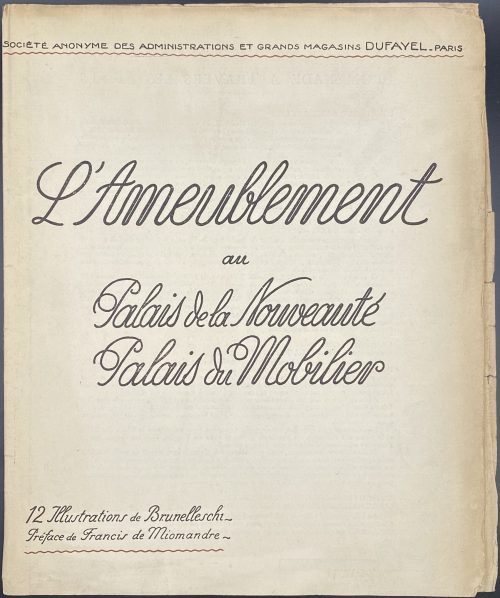 A set of 12 photomechanically reproduced illustrations after gouaches by Umberto Brunelleschi (Italian, 1879 – 1949), in colour; b/w photographs reproductions on verso, in a paper folder without the outer wrappers (b/w with birds, insects, and flowers). Text on the folder by French novelist Francis de Miomandre (French, 1880 – 1959); published by Grands Magasins Dufayel (1856 – 1930), a Parisian department store, run by Georges Dufayel (French, 1855 – 1916). Size: 29 x 24 cm. Images printed on cream paper within a beige frame, lettered above the frame in beige: "Societé Anonyme des Administrations et Grands Magasins DUFAYEL — Paris —", under the frame: "Palais de la Nouveauté ~ Palais du Mobilier | Entrée principale 7 Bould BARBES"; at the bottom of the frame lettered black on each image: Le Style Chinois, Le Style Empire, Le Style Japonais, Le Style Louis XIV, Le Style Louis XV, Le Style Louis XVI, Le Style Moderne (2), Le Style Moyen Age, Le Style Renaissance, Le Style Vénitien, Le Style Persian.
A set of 12 photomechanically reproduced illustrations after gouaches by Umberto Brunelleschi (Italian, 1879 – 1949), in colour; b/w photographs reproductions on verso, in a paper folder without the outer wrappers (b/w with birds, insects, and flowers). Text on the folder by French novelist Francis de Miomandre (French, 1880 – 1959); published by Grands Magasins Dufayel (1856 – 1930), a Parisian department store, run by Georges Dufayel (French, 1855 – 1916). Size: 29 x 24 cm. Images printed on cream paper within a beige frame, lettered above the frame in beige: "Societé Anonyme des Administrations et Grands Magasins DUFAYEL — Paris —", under the frame: "Palais de la Nouveauté ~ Palais du Mobilier | Entrée principale 7 Bould BARBES"; at the bottom of the frame lettered black on each image: Le Style Chinois, Le Style Empire, Le Style Japonais, Le Style Louis XIV, Le Style Louis XV, Le Style Louis XVI, Le Style Moderne (2), Le Style Moyen Age, Le Style Renaissance, Le Style Vénitien, Le Style Persian. -
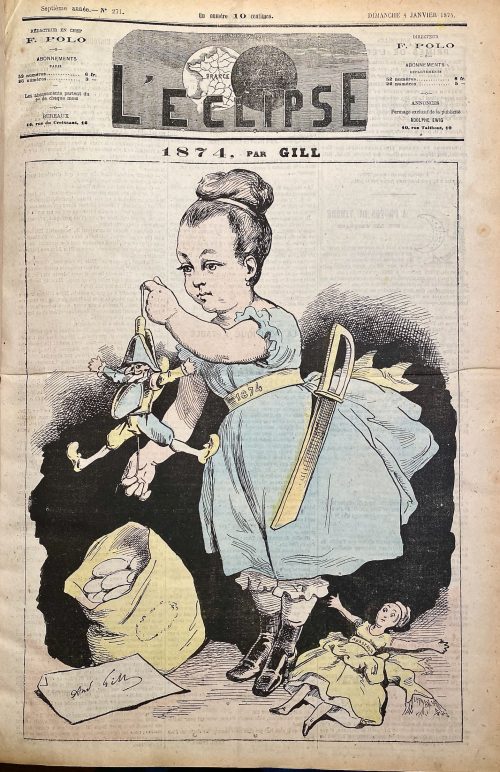 129 issues of L'Éclipse, French weekly political magazine; published in Paris, 49 x 34 cm, bound in rebacked green quarter morocco over marbled boards, with gilt fillets and lettering to spine, peacock marbled endpapers, illustrated by André Gill (French, 1840 – 1885). Founder and editor-in-chief François Polo (French, 1838 – 1874). 1874: 271-322 (52 issues) 1875: 323-374 (52 issues) 1876: 375-399 (25 issues)
129 issues of L'Éclipse, French weekly political magazine; published in Paris, 49 x 34 cm, bound in rebacked green quarter morocco over marbled boards, with gilt fillets and lettering to spine, peacock marbled endpapers, illustrated by André Gill (French, 1840 – 1885). Founder and editor-in-chief François Polo (French, 1838 – 1874). 1874: 271-322 (52 issues) 1875: 323-374 (52 issues) 1876: 375-399 (25 issues) -
 L'incendie de Hôtel de Ville (24 mai 1871). A woodcut by Provost; printed by Imp. Charaire et fils; F. Roy, éditier.
L'incendie de Hôtel de Ville (24 mai 1871). A woodcut by Provost; printed by Imp. Charaire et fils; F. Roy, éditier. -
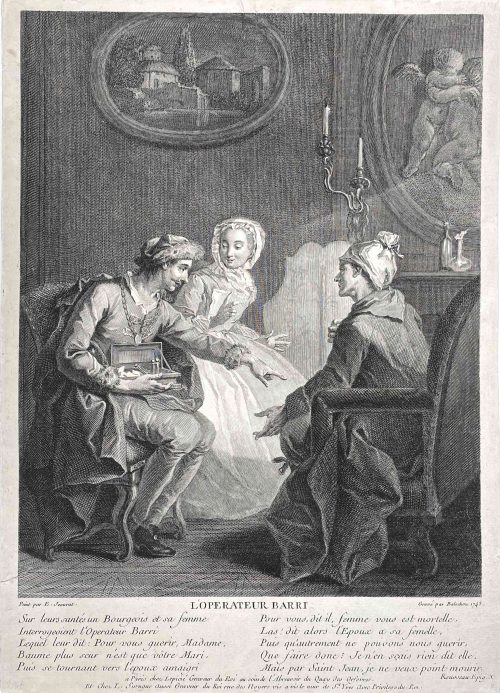
Engraving by J.J. Balechou after E. Jeaurat. A husband and wife ask a quack doctor for advice about health: he suggests substituting himself for the husband in the wife's affections, and she agrees: Épigrammes de Jean-Baptiste Rousseau (French, 1671–1741).
Date: 1743.
Size: 380 x 270 mm
Inscriptions under the image:
Top: Peint par E. Jeaurat | L'Operateur Barri | Grave par Balechou 1743
Middle: Sur leurs santés un Bourgeois et sa femme
Interrogeoient l'Operateur Barri, Lequel leur dit : Pour vous guérir, Madame, Baume plus sûr n'est que votre Mari, Puis se tournant vers l'époux amaigri, Pour vous, dit il, femme vous est mortelle, Las ! dit alors l'Epoux à sa femelle, Puis qu'autrement ne pouvons nous guérir, Que faire donc ? Je n'en sçai rien, dit elle,Mais, par Saint Jean, je ne veux point mourir.
Rousseau Epig. X
Center bottom: a Paris chez Lepicie Graveur du Roi au coin de l'Abreuvoir du Quay des Orfevres. Et Chez L. Surugue Aussi Graveur du Roi rue des Noyers vis a vis le mur de St. Yves Avec Privilege du Roi. -
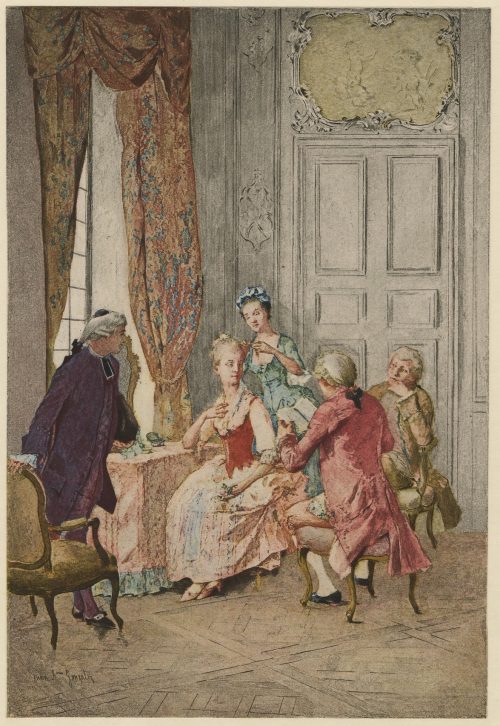
Coloured etching by E. Charreyre (French, fl. 1880 – ?) after a watercolour by Juan Antonio González, (Spanish, 1842 – 1914). A book illustration for 'Son Altesse La Femme' by Octave Uzanne (1851 – 1931), chapter: 'La Caillette' (Le lever d’une petite-maitresse au XVIIIe siècle). Published by Albert Quantin (French, 1850 – 1930) in 1885.
Size: print 17.5 x 12 cm, pasted to leaf 27.7 x 19.5 cm.
-
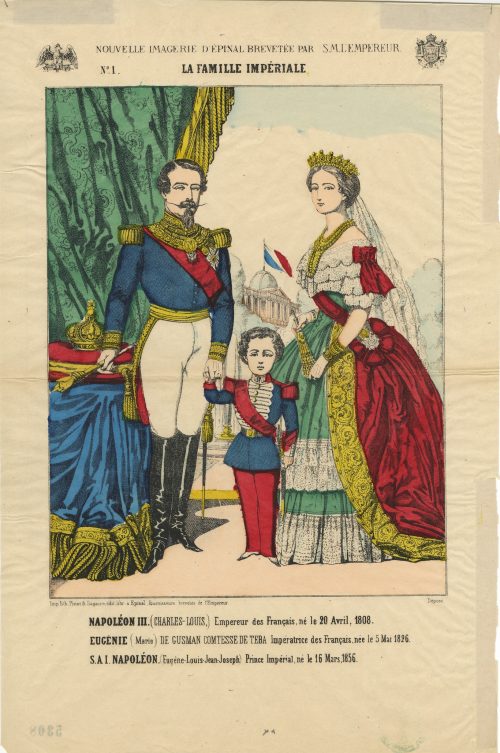 Hand-coloured woodcut on wove paper, 390 x 260 mm; black ink stamp “5308” to reverse; horizontal centerfold. Centre top: "NOUVELLE IMAGERIE D'ÉPINAL BREVETÉE PAR S.M.L’EMPEREUR" with imperial eagle and coat of arms at right and left. Below: "№ 1." — "LA FAMILLE IMPÉRIALE"; image in frame; under the image, left: "Imp lith. Pinot & Sagaire, édit. libr. à Épinal, fournisseurs brevetés de l’Empereur"; right: "Déposé". Bottom: "NAPOLÉON I. (CHARLES-LOUIS,) Empereur des Français, né le 20 Avril, 1808. | EUGÉNIE ( Marie) DE GUSMAN COMTESSE DE TEBA Impératrice des Français, née le 5 Mai 1826. | S.A I. NAPOLÉON. (Eugène-Louis-Jean-Joseph) Prince Impérial, ne le 16 Mars. 1856." Napoleon III [Charles-Louis Napoléon Bonaparte] (French, 1808 – 1873) Eugénie de Montijo [L'impératrice Eugénie] (Spanish-French, 1826 – 1920) Napoléon, Prince Imperial (Napoléon Eugène Louis Jean Joseph Bonaparte] (French, 1856 – 1879) Pinot & Sagaire (Épinal, 1861 – 1888) – enterprise, publisher/printer. Charles-François Pinot (French, 1817 – 1879) – publisher/printer.
Hand-coloured woodcut on wove paper, 390 x 260 mm; black ink stamp “5308” to reverse; horizontal centerfold. Centre top: "NOUVELLE IMAGERIE D'ÉPINAL BREVETÉE PAR S.M.L’EMPEREUR" with imperial eagle and coat of arms at right and left. Below: "№ 1." — "LA FAMILLE IMPÉRIALE"; image in frame; under the image, left: "Imp lith. Pinot & Sagaire, édit. libr. à Épinal, fournisseurs brevetés de l’Empereur"; right: "Déposé". Bottom: "NAPOLÉON I. (CHARLES-LOUIS,) Empereur des Français, né le 20 Avril, 1808. | EUGÉNIE ( Marie) DE GUSMAN COMTESSE DE TEBA Impératrice des Français, née le 5 Mai 1826. | S.A I. NAPOLÉON. (Eugène-Louis-Jean-Joseph) Prince Impérial, ne le 16 Mars. 1856." Napoleon III [Charles-Louis Napoléon Bonaparte] (French, 1808 – 1873) Eugénie de Montijo [L'impératrice Eugénie] (Spanish-French, 1826 – 1920) Napoléon, Prince Imperial (Napoléon Eugène Louis Jean Joseph Bonaparte] (French, 1856 – 1879) Pinot & Sagaire (Épinal, 1861 – 1888) – enterprise, publisher/printer. Charles-François Pinot (French, 1817 – 1879) – publisher/printer. -
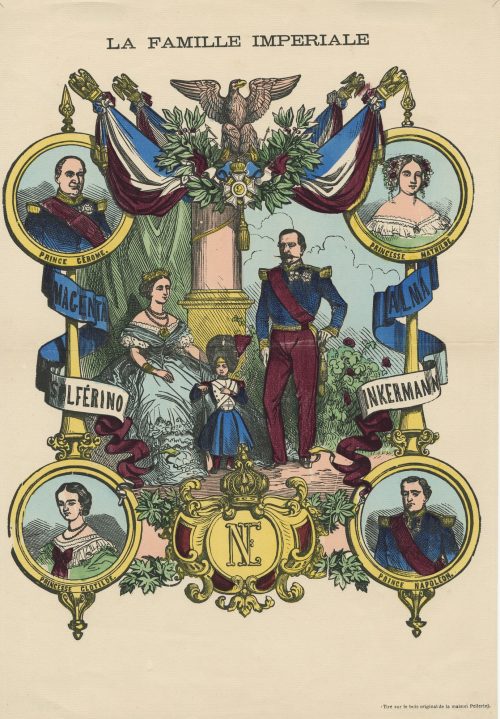 Hand-coloured woodcut on laid paper, 422 x 294 mm; black ink stamp “5307” to reverse, centrefold. Top center: "LA FAMILLE IMPERIALE"; Bottom right: "(Tire sur le bois original de maison Pellerin)". Image: Napoléon III, Empress Eugenie, and Prince Imperial Louis-Napoléon as a child surrounded with four lettered medallions: “PRINCE GÉROME”, “PRINCESSE MATHILDE”, “PRINCESSE CLOTILDE”, and “PRINCE NAPOLÉON”; ribbons lettered: “MAGENTA”, SOLFERINO”, “ALMA”, and “INKERMANN” around heraldic spears; coat of arms with imperial monogram between Princesse Clotilde and Prince Napoléon. Publisher/printer: Jean Charles Pellerin (French, 1756 – 1836). Battle of Magenta : 4 June 1859, against the Austrians. Battle of Solferino : 24 June 1859, against the Austrians. Battle of the Alma : 20 September 1854 (Crimean War) Battle of Inkerman : 5 November 1854 (Crimean War) Characters: Napoleon III [Charles-Louis Napoléon Bonaparte] (French, 1808 – 1873) Eugénie de Montijo [L'impératrice Eugénie] (Spanish-French, 1826 – 1920) Napoléon, Prince Imperial (Napoléon Eugène Louis Jean Joseph Bonaparte] (French, 1856 – 1879) Napoléon-Jérôme Bonaparte [Prince Jérôme] (French, 1822 – 1891) Mathilde Bonaparte [Princess Mathilde] (French, 1820 – 1904) Marie-Clotilde de Savoie [Princesse Clotilde] (French, 1843 – 1911)
Hand-coloured woodcut on laid paper, 422 x 294 mm; black ink stamp “5307” to reverse, centrefold. Top center: "LA FAMILLE IMPERIALE"; Bottom right: "(Tire sur le bois original de maison Pellerin)". Image: Napoléon III, Empress Eugenie, and Prince Imperial Louis-Napoléon as a child surrounded with four lettered medallions: “PRINCE GÉROME”, “PRINCESSE MATHILDE”, “PRINCESSE CLOTILDE”, and “PRINCE NAPOLÉON”; ribbons lettered: “MAGENTA”, SOLFERINO”, “ALMA”, and “INKERMANN” around heraldic spears; coat of arms with imperial monogram between Princesse Clotilde and Prince Napoléon. Publisher/printer: Jean Charles Pellerin (French, 1756 – 1836). Battle of Magenta : 4 June 1859, against the Austrians. Battle of Solferino : 24 June 1859, against the Austrians. Battle of the Alma : 20 September 1854 (Crimean War) Battle of Inkerman : 5 November 1854 (Crimean War) Characters: Napoleon III [Charles-Louis Napoléon Bonaparte] (French, 1808 – 1873) Eugénie de Montijo [L'impératrice Eugénie] (Spanish-French, 1826 – 1920) Napoléon, Prince Imperial (Napoléon Eugène Louis Jean Joseph Bonaparte] (French, 1856 – 1879) Napoléon-Jérôme Bonaparte [Prince Jérôme] (French, 1822 – 1891) Mathilde Bonaparte [Princess Mathilde] (French, 1820 – 1904) Marie-Clotilde de Savoie [Princesse Clotilde] (French, 1843 – 1911) -
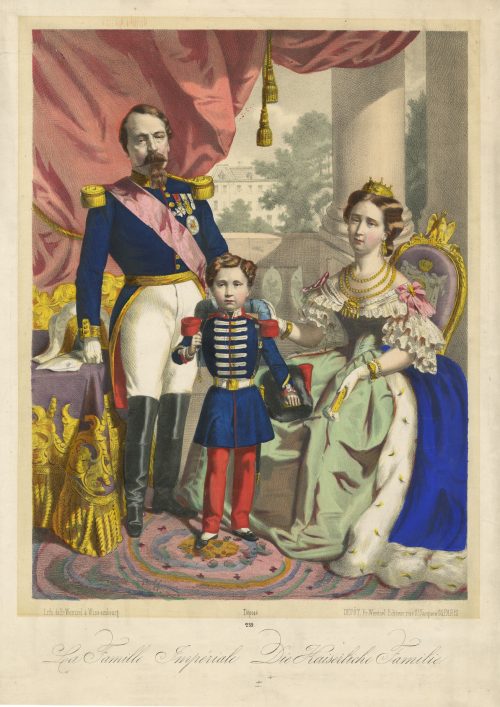 Hand-coloured lithography on wove paper, 395 x 280 mm; black ink stamp “5309” to reverse. On image: artist's initials "L. H."; on stone: "Lith. de Fr. Wentzel a Wissembourg. — Déposé — DÉPÔT, Fr. Wentzel Editeur rue St. Jacques 65, PARIS"; below centre: "239"; bottom : La famille Impériale. Die Kaizerliche Familie. Napoleon III [Charles-Louis Napoléon Bonaparte] (French, 1808 – 1873) Eugénie de Montijo [L'impératrice Eugénie] (Spanish-French, 1826 – 1920) Napoléon, Prince Imperial (Napoléon Eugène Louis Jean Joseph Bonaparte] (French, 1856 – 1879) Jean Frédéric Wentzel (French, 1807 – 1869) – publisher/printer.
Hand-coloured lithography on wove paper, 395 x 280 mm; black ink stamp “5309” to reverse. On image: artist's initials "L. H."; on stone: "Lith. de Fr. Wentzel a Wissembourg. — Déposé — DÉPÔT, Fr. Wentzel Editeur rue St. Jacques 65, PARIS"; below centre: "239"; bottom : La famille Impériale. Die Kaizerliche Familie. Napoleon III [Charles-Louis Napoléon Bonaparte] (French, 1808 – 1873) Eugénie de Montijo [L'impératrice Eugénie] (Spanish-French, 1826 – 1920) Napoléon, Prince Imperial (Napoléon Eugène Louis Jean Joseph Bonaparte] (French, 1856 – 1879) Jean Frédéric Wentzel (French, 1807 – 1869) – publisher/printer. -
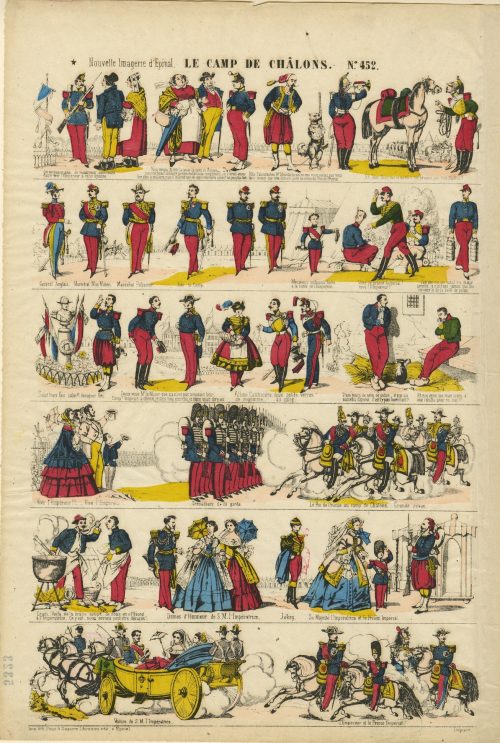 Hand-coloured woodcut on wove paper, 409 x 280 mm; black ink stamp “5323” to reverse; attached to the sheet 487 x 320 mm. Top centre: "LE CAMP DE CHALONS."; left: "Nouvelle Imagerre d'Epinal"; right: № 452. Bottom left: "Imp lith. Pinot & Sagaire, libraires edit. à Épinal"; right: "Déposé". Image: 6-tier cartoon with captions about Napoleon III and his son Prince Imperial (Napoléon Eugène Louis Jean Joseph Bonaparte; 16 March 1856 – 1 June 1879). Le camp de Chalons Pinot & Sagaire (Épinal, 1861 – 1888) – enterprise, publisher/printer. Charles-François Pinot (French, 1817 – 1879) – publisher/printer.
Hand-coloured woodcut on wove paper, 409 x 280 mm; black ink stamp “5323” to reverse; attached to the sheet 487 x 320 mm. Top centre: "LE CAMP DE CHALONS."; left: "Nouvelle Imagerre d'Epinal"; right: № 452. Bottom left: "Imp lith. Pinot & Sagaire, libraires edit. à Épinal"; right: "Déposé". Image: 6-tier cartoon with captions about Napoleon III and his son Prince Imperial (Napoléon Eugène Louis Jean Joseph Bonaparte; 16 March 1856 – 1 June 1879). Le camp de Chalons Pinot & Sagaire (Épinal, 1861 – 1888) – enterprise, publisher/printer. Charles-François Pinot (French, 1817 – 1879) – publisher/printer. -
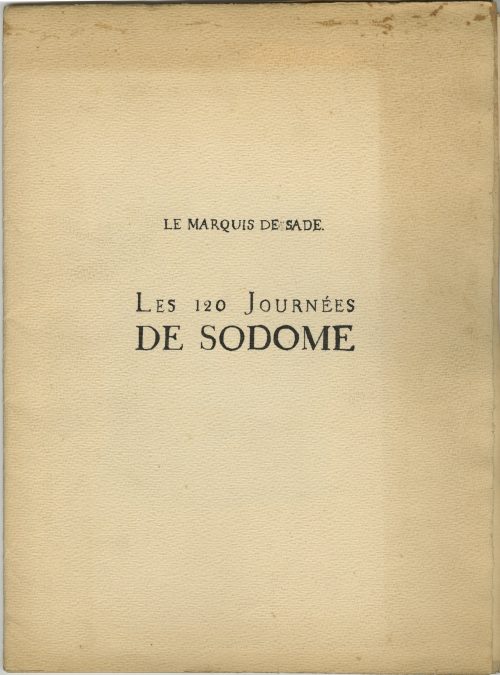 A set of sixteen pen and ink wash drawings on wove paper by an anonymous artist after lithographs by André Collot, who illustrated the 1935 edition of Les 120 journées de Sodome, ou l’école du libertinage, by the Marquis de Sade, based on the original autograph manuscript by Maurice Heine. The set is housed in a rough texture paper folder with an ink manuscript to the front: LE MARQUIS DE SADE. | Les 120 journées | DE SODOME || Size: 340 x 250 mm (folder); 335 x 252 (sheet); approx. 160 x 110 (image). Contributors: Donatien Alphonse François, Marquis de Sade (French, 1740 – 1814) – author. Maurice Heine (French, 1884 – 1940) – publisher of the original Les 120 journées. André Collot (French, 1897-1976) – artist of the original illustrations for the 1935 edition. This set was produced by an anonymous artist from the bohemian Montmartre, Montparnasse, or the School of Fine Arts, close to the booksellers', by demand of an excentric bibliophile, at about the same time. Collot's illustrations can be found at www.honesterotica.com.
A set of sixteen pen and ink wash drawings on wove paper by an anonymous artist after lithographs by André Collot, who illustrated the 1935 edition of Les 120 journées de Sodome, ou l’école du libertinage, by the Marquis de Sade, based on the original autograph manuscript by Maurice Heine. The set is housed in a rough texture paper folder with an ink manuscript to the front: LE MARQUIS DE SADE. | Les 120 journées | DE SODOME || Size: 340 x 250 mm (folder); 335 x 252 (sheet); approx. 160 x 110 (image). Contributors: Donatien Alphonse François, Marquis de Sade (French, 1740 – 1814) – author. Maurice Heine (French, 1884 – 1940) – publisher of the original Les 120 journées. André Collot (French, 1897-1976) – artist of the original illustrations for the 1935 edition. This set was produced by an anonymous artist from the bohemian Montmartre, Montparnasse, or the School of Fine Arts, close to the booksellers', by demand of an excentric bibliophile, at about the same time. Collot's illustrations can be found at www.honesterotica.com. -
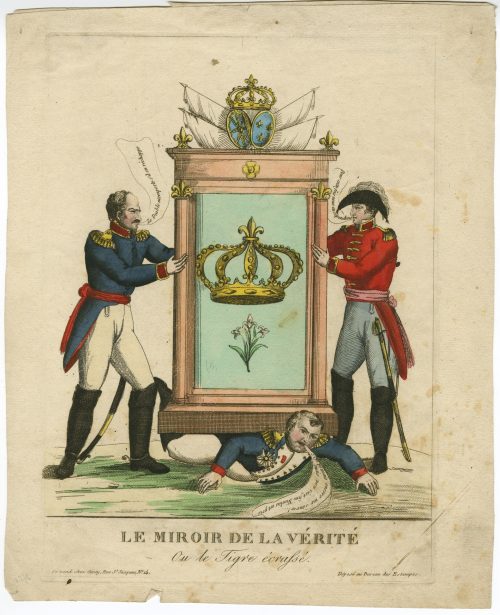 Hand-coloured etching by an anonymous artist, printed in July 1815. Description by British Museum (1866,0407.935): "Blücher (left) and Napoleon (right) support a heavy pier-glass in an upright position. Its solid base rests on the back of the prostrate Napoleon, from whose mouth issues a label: 'Si je pouvais encore me sauver! . . . mais non c'est fini Nicolas est pris.' The mirror, which towers above the head of its supporters, is framed by pillars, each surmounted by a fleur-de-lis. These also decorate the heavy superstructure which supports a trophy of two oval shields with the arms of Bourbon and Navarre, surmounted by a crown..., and four white flags. On the face of the mirror is a large Bourbon crown, and a lily plant. Blücher says: "Le Diable m'emporte s'il en réchappe." Wellington responds: "Pour cette fois nous en répondons." Inscription under the plate: 'Se vend chez Genty, rue St Jacques no.14' and 'Déposé au Bureau des Estampes'. Size: 33.2 x 25.7 cm
Hand-coloured etching by an anonymous artist, printed in July 1815. Description by British Museum (1866,0407.935): "Blücher (left) and Napoleon (right) support a heavy pier-glass in an upright position. Its solid base rests on the back of the prostrate Napoleon, from whose mouth issues a label: 'Si je pouvais encore me sauver! . . . mais non c'est fini Nicolas est pris.' The mirror, which towers above the head of its supporters, is framed by pillars, each surmounted by a fleur-de-lis. These also decorate the heavy superstructure which supports a trophy of two oval shields with the arms of Bourbon and Navarre, surmounted by a crown..., and four white flags. On the face of the mirror is a large Bourbon crown, and a lily plant. Blücher says: "Le Diable m'emporte s'il en réchappe." Wellington responds: "Pour cette fois nous en répondons." Inscription under the plate: 'Se vend chez Genty, rue St Jacques no.14' and 'Déposé au Bureau des Estampes'. Size: 33.2 x 25.7 cm -
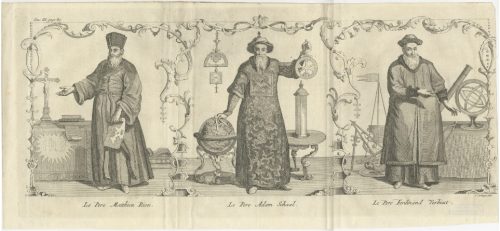
Three priests: Le Pere Matthieu Ricci, Le Pere Adam Schaal, and Le Pere Ferdinand Verbiest. Three priests with navigational instruments. Image taken from Description geographique, historique, chronologique et physique de l'Empire de la Chine et de la Tartarie Chinoise. Enrichies des cartes generales et particulieres de ces pays, etc. by Jean-Baptiste Du Halde (1674–1743), vol. 3, page 78. Originally published/produced in La Haye [The Hague], 1736. J.v.Solingen fecit
Jean-Baptiste Du Halde (Chinese: 杜赫德; 1 February 1674 – 18 August 1743) was a French Jesuit historian specializing in China. He did not travel to China, but collected seventeen Jesuit missionaries' reports and provided an encyclopedic survey of the history, culture and society of China and "Chinese Tartary," that is, Manchuria. Voltaire said of Du Halde's work: "Although it is developed out of Paris, and he hath not known the Chinese, [he] gave on the basis of the memoirs of his colleagues, the widest and the best description the empire of China has had worldwide." Le Pere Matthieu Ricci, a.k.a. Matteo Ricci, S.J. (Italian pronunciation: [matˈtɛːo ˈrittʃi]; Latin: Mattheus Riccius Maceratensis; 6 October 1552 – 11 May 1610), was an Italian Jesuit priest and one of the founding figures of the Jesuit China missions. His 1602 map of the world in Chinese characters introduced the findings of European exploration to East Asia. He is considered a Servant of God by the Roman Catholic Church. Ricci arrived at the Portuguese settlement of Macau in 1582 where he began his missionary work in China. He became the first European to enter the Forbidden City of Beijing in 1601 when invited by the Wanli Emperor, who sought his services in matters such as court astronomy and calendrical science. He converted several prominent Chinese officials to Catholicism, such as Xu Guangqi, who aided in translating Euclid's Elements into Chinese as well as the Confucian classics into Latin for the first time. Le Pere Adam Schaal, a.k.a. Johann Adam Schall von Bell (1 May 1591 – 15 August 1666) was a German Jesuit and astronomer. He spent most of his life as a missionary in China (where he is remembered as "Tang Ruowang") and became an adviser to the Shunzhi Emperor of the Qing dynasty. Le Pere Ferdinand Verbiest, a.k.a. Father Ferdinand Verbiest (9 October 1623 – 28 January 1688) was a Flemish Jesuit missionary in China during the Qing dynasty. He was born in Pittem near Tielt in the County of Flanders (now part of Belgium). He is known as Nan Huairen (南懷仁) in Chinese. He was an accomplished mathematician and astronomer and proved to the court of the Kangxi Emperor that European astronomy was more accurate than Chinese astronomy. He then corrected the Chinese calendar and was later asked to rebuild and re-equip the Beijing Ancient Observatory, being given the role of Head of the Mathematical Board and Director of the Observatory. He became close friends with the Kangxi Emperor, who frequently requested his teaching, in geometry, philosophy and music. Verbiest worked as a diplomat and cartographer, and also as a translator because he spoke Latin, German, Dutch, Spanish, Hebrew, and Italian. He wrote more than thirty books. During the 1670s, Verbiest designed what some claim to be the first ever self-propelled vehicle – many claims this as the world's first automobile, in spite of its small size and the lack of evidence that it was actually built.Joshua Van Solingen was an engraver and publisher from Holland, working, besides other places, in Scotland. Information about him can be found at Catastrophic Bliss (The Griot Project Book Series) by Accounting in Scotland (RLE Accounting): A Historical Bibliography History of the Scottish Metrical Psalms: With an Account of the Paraphrases ... The History of Edinburgh, from the Earliest Accounts to the Present Time ... History of the Bassandyne Bible, the First Printed in Scotland: With Notices ...
-
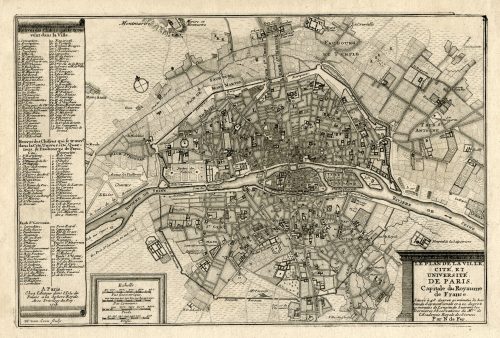 LE PLAN DE LA VILLE, | CITE, ET | UNIVERSITÉ | DE PARIS. | Capitale du Royaume | de France. | {5 lines in italic} | Par N. de Fer. | A Paris, | Chez l’Auteur dans l’Isle du | Palais a la Sphere Royale. | Avec Privilege du Roy. | 1705 | H. van Loon sculp. || Dimensions: Sheet: 27 x 39 cm; Image: 22 x 33 cm. Contributors: Nicolas de Fer (French, 1646 – 1720) – cartographer. Harmanus van Loon (Flemish, fl. c. 1690 – c. 1725) – engraver.
LE PLAN DE LA VILLE, | CITE, ET | UNIVERSITÉ | DE PARIS. | Capitale du Royaume | de France. | {5 lines in italic} | Par N. de Fer. | A Paris, | Chez l’Auteur dans l’Isle du | Palais a la Sphere Royale. | Avec Privilege du Roy. | 1705 | H. van Loon sculp. || Dimensions: Sheet: 27 x 39 cm; Image: 22 x 33 cm. Contributors: Nicolas de Fer (French, 1646 – 1720) – cartographer. Harmanus van Loon (Flemish, fl. c. 1690 – c. 1725) – engraver. -
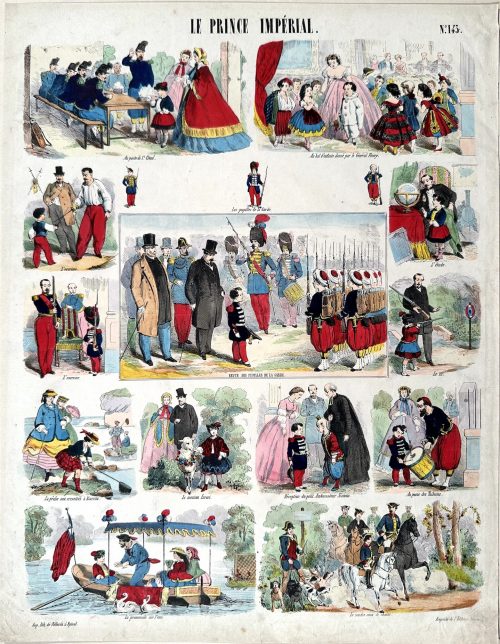 Hand-coloured woodcut on wove paper, 472 x 365 mm; black ink stamp “5275” to reverse. Top centre: "LE PRINCE IMPÉRIAL"; right: "№143." Image in the middle: Prince Impérial, with his father, conducts a review of the children's army "REVUE DES PUPILLES DE LA GARDE". Besides – five tiers of captioned cartoons. Bottom left: "Imp. lith. de Pellerin à Épinal"; right: Propriété de l’Éditeur. Déposé." Jean Charles Pellerin (French, 1756 – 1836) – printer/publisher.
Hand-coloured woodcut on wove paper, 472 x 365 mm; black ink stamp “5275” to reverse. Top centre: "LE PRINCE IMPÉRIAL"; right: "№143." Image in the middle: Prince Impérial, with his father, conducts a review of the children's army "REVUE DES PUPILLES DE LA GARDE". Besides – five tiers of captioned cartoons. Bottom left: "Imp. lith. de Pellerin à Épinal"; right: Propriété de l’Éditeur. Déposé." Jean Charles Pellerin (French, 1756 – 1836) – printer/publisher. -
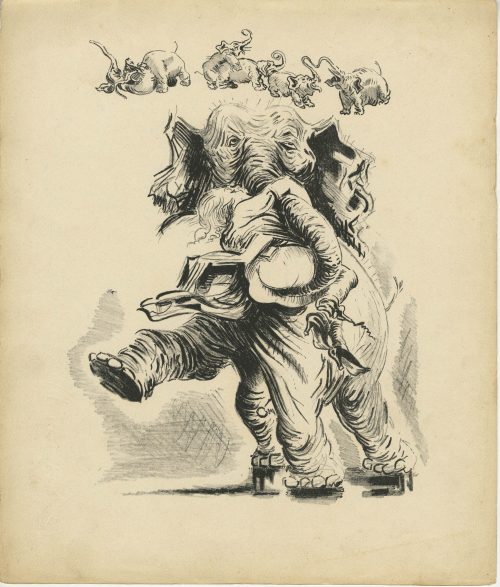
Album of 20 hand-coloured lithographs with a title page and a 'justification du tirage' page in an original snakeskin-clothed cardboard binder. Drawn on stone by Anonymous, attributed to Santippa. The theme of these pictures can be described as erotic humour.
Edition: 200 copies printed in Bruxelles, c. 1938; this copy without a number.
Watermarked wove paper: Word "Marais" and a flower.
Dimensions: 24.3 x 29.3 cm According to J.-P. Dutel, the author of these images is Georges Hoffmann under the pseudonym Santippa. Honesterotica provides a different name: Gaston Hoffmann [Santippa] (French, 1883 – 1977), which seems adequate. Catalogue raisonné: Dutel (1920-70): 2496. -
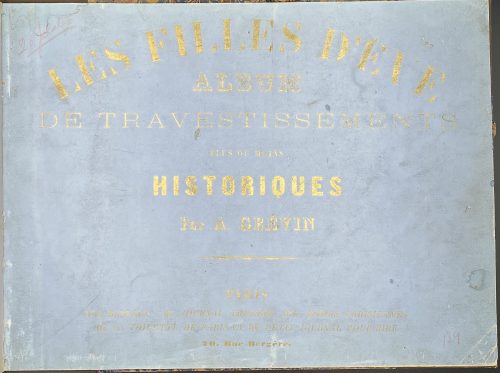 Pictorial album of 20 hand-coloured wood engravings by Firmin Gillot after Alfred Grévin; numbered 1 to 20, bound with tissue guards in half-brown cloth over marbled boards, publisher's gilt-lettered blue wrappers preserved, purple-blueish endpapers. Front wrapper (gilt on blue): LES FILLES D'EVE | ALBUM | DE TRAVESTISSEMENTS | PLUS OU MOINS | HISTORIQUES | Par A. GRÉVIN | — | PARIS | AUX BUREAUX : DU JOURNAL AMUSANT, DES MODES PARISIENNES | DE LA TOILETTE DE PARIS ET DU PETIT JOURNAL POUR RIRE | 20. Rue Bergère. || ; Henri Plon's imprint to back wrapper. Contributors: Grevin, Alfred (French, 1827 – 1892) Gillot, Firmin (French, 1820 – 1872) Plon, Henri (French, 1806 – 1872) Ref.: Metropoliten Museum.
Pictorial album of 20 hand-coloured wood engravings by Firmin Gillot after Alfred Grévin; numbered 1 to 20, bound with tissue guards in half-brown cloth over marbled boards, publisher's gilt-lettered blue wrappers preserved, purple-blueish endpapers. Front wrapper (gilt on blue): LES FILLES D'EVE | ALBUM | DE TRAVESTISSEMENTS | PLUS OU MOINS | HISTORIQUES | Par A. GRÉVIN | — | PARIS | AUX BUREAUX : DU JOURNAL AMUSANT, DES MODES PARISIENNES | DE LA TOILETTE DE PARIS ET DU PETIT JOURNAL POUR RIRE | 20. Rue Bergère. || ; Henri Plon's imprint to back wrapper. Contributors: Grevin, Alfred (French, 1827 – 1892) Gillot, Firmin (French, 1820 – 1872) Plon, Henri (French, 1806 – 1872) Ref.: Metropoliten Museum. -
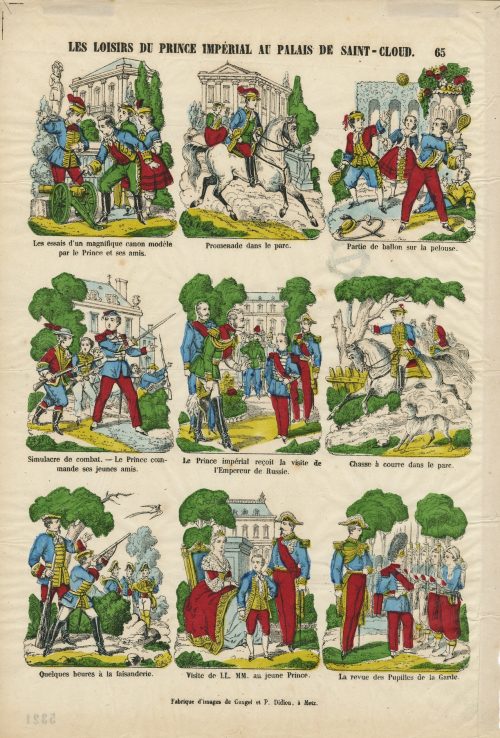 Hand-coloured woodcut on wove paper, 400 x 280 mm; black ink stamp “5321” to reverse. Top: "LES LOISIRS DU PRINCE IMPERIAL AU PALAIS DE SAINT- CLOUD" — "65". Below: nine cartoons with captions.
Hand-coloured woodcut on wove paper, 400 x 280 mm; black ink stamp “5321” to reverse. Top: "LES LOISIRS DU PRINCE IMPERIAL AU PALAIS DE SAINT- CLOUD" — "65". Below: nine cartoons with captions.- Les essais d'un magnifique canon modèle par le Prince et ses amis.
- Promenade dans le parc.
- Partie de ballon sur la pelouse.
- Simulacre de combat. — Le Prince commande ses jeunes amis.
- le Prince impérial reçoit la visite de l'Empereur de Russie.
- Chasse à courre dans le parc.
- Quelques heures à la faisanderie.
- Visite de LL. MM. au jeune Prince.
- La revue des Pupilles de la Garde.
-
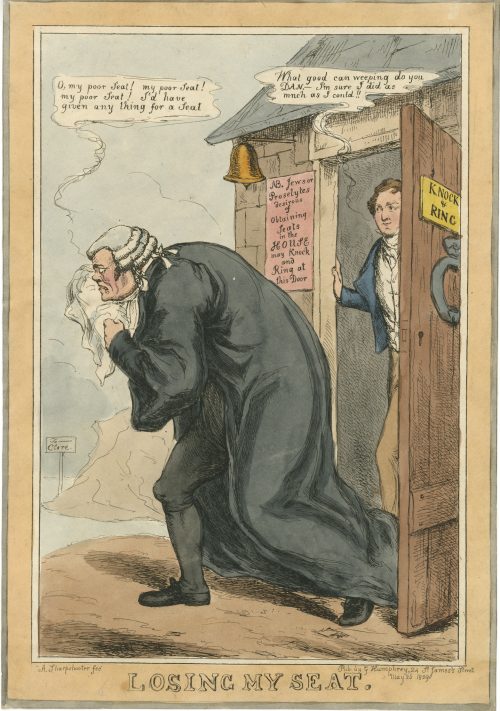 Hand-coloured etching by an anonymous British artist, printed on May 26, 1829, in London. Description by British Museum (1868,0808.8988): "O'Connell, in wig and gown, walks to the left from the massive door of a small stone building, stooping, and holding his handkerchief to his right eye. He wails: 'O, my poor Seat! my poor Seat! my poor Seat! I'd have given any thing for a seat.' In the doorway (right) stands Peel, saying with wary blandness: 'What good can weeping do you Dan.—I'm sure I did as much as I could!!' Above the large knocker on the plank door is 'Knock & Ring'. There is a projecting bell, above a placard: 'NB. Jews or Proselytes desirous of Obtaining Seats in the House may Knock and Ring at this Door.' One corner of "the House", a small stone shed, is depicted. O'Connell is walking towards a strip of water, across which is a mountain, with a board pointing 'To — Clare'. Comment by BM: "Catholic Emancipation raised high hopes among Jews; the first Bill, after a petition from Jews in Liverpool, was introduced 15 Apr. 1830, but Jewish Emancipation did not become law till 1858." Inscription under the frame with title, "A. Sharpshooter fec", text within image and publication line: "Pub. by G. Humphrey, 24 St. James's Street May 26 1829". Size: 37.5 x 26 cm.
Hand-coloured etching by an anonymous British artist, printed on May 26, 1829, in London. Description by British Museum (1868,0808.8988): "O'Connell, in wig and gown, walks to the left from the massive door of a small stone building, stooping, and holding his handkerchief to his right eye. He wails: 'O, my poor Seat! my poor Seat! my poor Seat! I'd have given any thing for a seat.' In the doorway (right) stands Peel, saying with wary blandness: 'What good can weeping do you Dan.—I'm sure I did as much as I could!!' Above the large knocker on the plank door is 'Knock & Ring'. There is a projecting bell, above a placard: 'NB. Jews or Proselytes desirous of Obtaining Seats in the House may Knock and Ring at this Door.' One corner of "the House", a small stone shed, is depicted. O'Connell is walking towards a strip of water, across which is a mountain, with a board pointing 'To — Clare'. Comment by BM: "Catholic Emancipation raised high hopes among Jews; the first Bill, after a petition from Jews in Liverpool, was introduced 15 Apr. 1830, but Jewish Emancipation did not become law till 1858." Inscription under the frame with title, "A. Sharpshooter fec", text within image and publication line: "Pub. by G. Humphrey, 24 St. James's Street May 26 1829". Size: 37.5 x 26 cm. -
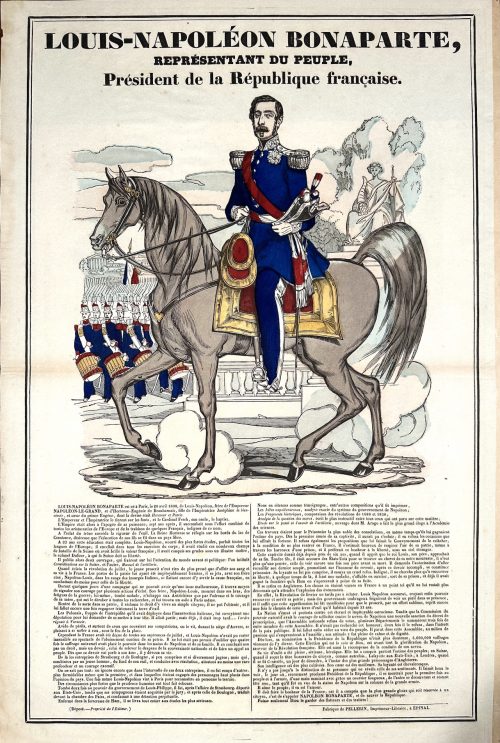 Hand-coloured woodcut poster on wove paper, 622 x 417 mm; black ink stamp “4859” to reverse, horizontal centrefold. In a double frame, top: LOUIS-NAPOLÉON BONAPARTE, | REPRÉSENTANT DU PEUPLE, | Président de la République française. Text under the image ; bottom left: (Déposé.— Propriété de l’Éditeur.); right: Fabrique de PELLERIN, Imprimeur-Libraire, à ÉPINAL. Jean Charles Pellerin (French, 1756 – 1836) – printer/publisher.
Hand-coloured woodcut poster on wove paper, 622 x 417 mm; black ink stamp “4859” to reverse, horizontal centrefold. In a double frame, top: LOUIS-NAPOLÉON BONAPARTE, | REPRÉSENTANT DU PEUPLE, | Président de la République française. Text under the image ; bottom left: (Déposé.— Propriété de l’Éditeur.); right: Fabrique de PELLERIN, Imprimeur-Libraire, à ÉPINAL. Jean Charles Pellerin (French, 1756 – 1836) – printer/publisher. -

-

-
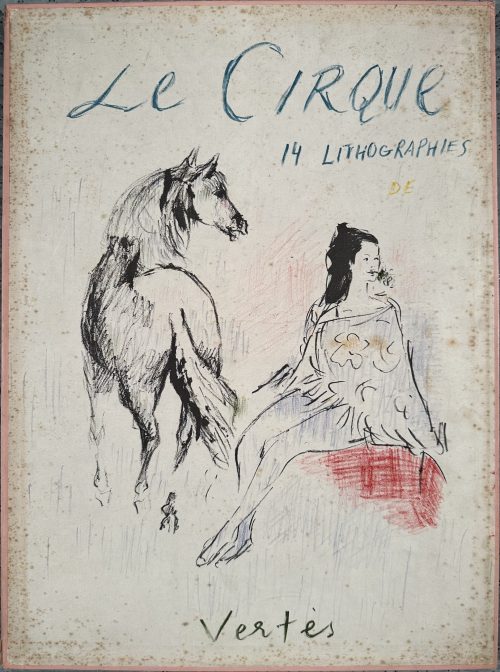 Publisher’s peach cloth box 555 x 410 mm with coloured lithograph on the lid, autographed with crayons "Le Cirque | 14 LITHOGRAPHIES | DE | {vignette} | Vertes"; in-folio unbound 4 pp. booklet on laid paper watermarked “Marais” and 14 loose leaves of plates on laid paper 520 x 395 mm without a watermark with coloured lithographs signed “Vertes” and numbered “195/250” in pencil; interleaved with tracing paper. Box and plates foxed. Title-page (red and black): LE | CIRQUE | 14 LITHOGRAPHIES DE | VERTÈS | PRÉSENTÉ | PAR | JEAN COCTEAU || Imprint: LES LIVES MERVEILLEUX | MONACO | Il a été tiré de cet album : | 150 Exemplaires, | destinés à | l'Amérique, | distribués bar les soins de | Arthur H. Harlow | de New-York, | & | 100 Exemplaires, | réservés à la France. | 15 Avril 1949 || Limitation: Edition limited to 250 copies (150 for USA, 100 for France); this is copy № 195 printed for France as the American copies marked “Published by Arthur H. Harlow & Co., New York. Seller’s Description: VERTÈS, Marcel (Hungarian-French, 1895-1961). Le Cirque 14 Lithographies de Vertès. Présénte par Jean Cocteau. [Monaco: Les Livres Merveilleux, 1949]. [vi] pp. With all 14 lithographs, each signed by the artist and numbered “195/250”. Text and lithographs 15 ¼ x 20 ½”. In original publisher’s peach cloth box with printed label on lid (box foxed, soiled, lightly worn; lithographs and text foxed). Still, a very good example of this lovely collection, with an introduction by Jean Cocteau (1889-1963). Catalogue Raisonné: Vokaer № 50. Marcel Vertès [Marcell Vértes] (Jewish-Hungarian-French, 1895 – 1961) – artist. Arthur H. Harlow (American, c. 1877 – 1958) – publisher. Jean Cocteau (French, 1889 – 1963) – author.
Publisher’s peach cloth box 555 x 410 mm with coloured lithograph on the lid, autographed with crayons "Le Cirque | 14 LITHOGRAPHIES | DE | {vignette} | Vertes"; in-folio unbound 4 pp. booklet on laid paper watermarked “Marais” and 14 loose leaves of plates on laid paper 520 x 395 mm without a watermark with coloured lithographs signed “Vertes” and numbered “195/250” in pencil; interleaved with tracing paper. Box and plates foxed. Title-page (red and black): LE | CIRQUE | 14 LITHOGRAPHIES DE | VERTÈS | PRÉSENTÉ | PAR | JEAN COCTEAU || Imprint: LES LIVES MERVEILLEUX | MONACO | Il a été tiré de cet album : | 150 Exemplaires, | destinés à | l'Amérique, | distribués bar les soins de | Arthur H. Harlow | de New-York, | & | 100 Exemplaires, | réservés à la France. | 15 Avril 1949 || Limitation: Edition limited to 250 copies (150 for USA, 100 for France); this is copy № 195 printed for France as the American copies marked “Published by Arthur H. Harlow & Co., New York. Seller’s Description: VERTÈS, Marcel (Hungarian-French, 1895-1961). Le Cirque 14 Lithographies de Vertès. Présénte par Jean Cocteau. [Monaco: Les Livres Merveilleux, 1949]. [vi] pp. With all 14 lithographs, each signed by the artist and numbered “195/250”. Text and lithographs 15 ¼ x 20 ½”. In original publisher’s peach cloth box with printed label on lid (box foxed, soiled, lightly worn; lithographs and text foxed). Still, a very good example of this lovely collection, with an introduction by Jean Cocteau (1889-1963). Catalogue Raisonné: Vokaer № 50. Marcel Vertès [Marcell Vértes] (Jewish-Hungarian-French, 1895 – 1961) – artist. Arthur H. Harlow (American, c. 1877 – 1958) – publisher. Jean Cocteau (French, 1889 – 1963) – author. -
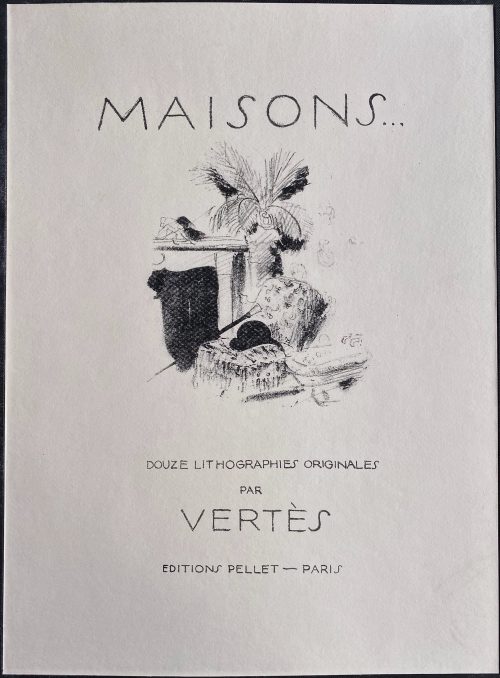 Album in-folio of 13 lithographs by Marcel Vertès, incl. title-page, each in a passe-partout 41.5 x 31.7 cm with 33.0 x 23.0 cm window, printed on wove paper sheets 38.0 x 28.0 cm and crayon-coloured by the artist; graphite pencil drawings by Marcel Vertès on the lower-right corner of each passe-partout; all in a buckram-backed flapped folder, signed ‘AT BOICHOT’, with an uncoloured title-page lithograph on front cover. Edition limited to 100 copies on Chine (№№ 1-100) and 900 on Vélin (№№ 1 to 900); this is a copy № 22 (Vélin), unique as enhanced by the artist. Double-folio leaf 41 x 31 cm with text by Pierre Mac-Orlan. These lithographs, uncoloured, were used in Pierre Mac-Orlan. Les jeux du demi-jour / avec douze lithographies de Vertès. — Paris: Les arts et le livre, 1926 [LIB-2893.2021]. Lithographed title-page: MAISONS.... | {vignette} | DOUZE LITHOGRAPHIES ORIGINALES | PAR | VERTÈS | ÉDITIONS PELLET ~ PARIS || Catalogue raisonné: Vokaer: № 5, p. 7; Nordmann (1): 423, p. 267. Contributors: Pierre Mac-Orlan (French, 1882 – 1970) – author. Marcel Vertès [Marcell Vértes] (Jewish-Hungarian-French, 1895 – 1961) – artist. Gustave Pellet (1859 – 1919) – publisher. Thomas Boichot – bookbinder. Description by J.-P. Dutel: MAC ORLAN Pierre. VERTES Marcel. MAISONS... Douze lithographies originales. Paris, Editions Pellet, [1925]. In-folio (410 x 310 mm) de [4] ff. et 13 lithographies sous passe-partout dont un titre. Chemise en demi-soienoire, premier plat illustré de la même lithographie que celle utilisée pour le titre (AT Boichot). TIRAGE : 100 albums sur chine avant la signature gravée, chaque planche signée. 900 albums sur vélin. :Un des 900 albums sur vélin (n° 22). EXEMPLAIRE UNIQUE DANS LEQUEL LES 13 LITHOGRAPHIES ONT ÉTÉCOLORIÉES AUX CRAYONS DE COULEURS PAR VERTÈS. DE PLUS, CHAQUE PASSE-PARTOUT COMPORTE EN BAS À DROITE UN CROQUIS ORIGINAL À LA MINE DE PLOMB CORRESPONDANT À UNE VERSION PLUS LIBRE DELA LITHO.
Album in-folio of 13 lithographs by Marcel Vertès, incl. title-page, each in a passe-partout 41.5 x 31.7 cm with 33.0 x 23.0 cm window, printed on wove paper sheets 38.0 x 28.0 cm and crayon-coloured by the artist; graphite pencil drawings by Marcel Vertès on the lower-right corner of each passe-partout; all in a buckram-backed flapped folder, signed ‘AT BOICHOT’, with an uncoloured title-page lithograph on front cover. Edition limited to 100 copies on Chine (№№ 1-100) and 900 on Vélin (№№ 1 to 900); this is a copy № 22 (Vélin), unique as enhanced by the artist. Double-folio leaf 41 x 31 cm with text by Pierre Mac-Orlan. These lithographs, uncoloured, were used in Pierre Mac-Orlan. Les jeux du demi-jour / avec douze lithographies de Vertès. — Paris: Les arts et le livre, 1926 [LIB-2893.2021]. Lithographed title-page: MAISONS.... | {vignette} | DOUZE LITHOGRAPHIES ORIGINALES | PAR | VERTÈS | ÉDITIONS PELLET ~ PARIS || Catalogue raisonné: Vokaer: № 5, p. 7; Nordmann (1): 423, p. 267. Contributors: Pierre Mac-Orlan (French, 1882 – 1970) – author. Marcel Vertès [Marcell Vértes] (Jewish-Hungarian-French, 1895 – 1961) – artist. Gustave Pellet (1859 – 1919) – publisher. Thomas Boichot – bookbinder. Description by J.-P. Dutel: MAC ORLAN Pierre. VERTES Marcel. MAISONS... Douze lithographies originales. Paris, Editions Pellet, [1925]. In-folio (410 x 310 mm) de [4] ff. et 13 lithographies sous passe-partout dont un titre. Chemise en demi-soienoire, premier plat illustré de la même lithographie que celle utilisée pour le titre (AT Boichot). TIRAGE : 100 albums sur chine avant la signature gravée, chaque planche signée. 900 albums sur vélin. :Un des 900 albums sur vélin (n° 22). EXEMPLAIRE UNIQUE DANS LEQUEL LES 13 LITHOGRAPHIES ONT ÉTÉCOLORIÉES AUX CRAYONS DE COULEURS PAR VERTÈS. DE PLUS, CHAQUE PASSE-PARTOUT COMPORTE EN BAS À DROITE UN CROQUIS ORIGINAL À LA MINE DE PLOMB CORRESPONDANT À UNE VERSION PLUS LIBRE DELA LITHO. -
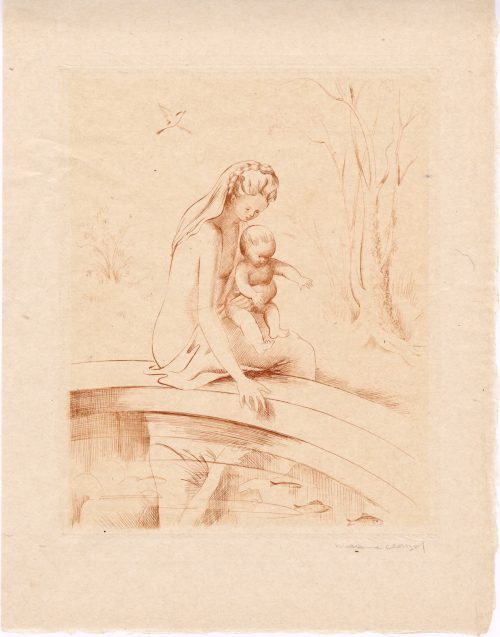 Set of 10 etchings (9 in passe-partout) printed in sanguine on the mother of pearl paper (japon nacre) from the album of 12 prints titled “Jeunesse”, presented by Gérard D'Houville (pen name of Marie de Régnier, née de Heredia) and published by La Tradition in 1945. It was a limited edition of 532 copies, some coloured on Arches paper and some as these set. Plates signed by the artist in pencil below the plate mark. The album cover is missing. Complete data for the album: JEUNESSE | 12 EAUX-FORTES ORIGINALES | DE | MARIANNE CLOUZOT | PRÉSENTÉES | PAR | GÉRARD D'HOUVILLE | {publisher’s device} | LA TRADITION | 1945 || Dimensions: mat 330 x 255 mm; window 225 x 180 mm; sheet 280 x 220 mm; plate 220 x 170 mm. Contributor: Martin van Maële [Martin, Maurice François Alfred] (French, 1863 – 1926)
Set of 10 etchings (9 in passe-partout) printed in sanguine on the mother of pearl paper (japon nacre) from the album of 12 prints titled “Jeunesse”, presented by Gérard D'Houville (pen name of Marie de Régnier, née de Heredia) and published by La Tradition in 1945. It was a limited edition of 532 copies, some coloured on Arches paper and some as these set. Plates signed by the artist in pencil below the plate mark. The album cover is missing. Complete data for the album: JEUNESSE | 12 EAUX-FORTES ORIGINALES | DE | MARIANNE CLOUZOT | PRÉSENTÉES | PAR | GÉRARD D'HOUVILLE | {publisher’s device} | LA TRADITION | 1945 || Dimensions: mat 330 x 255 mm; window 225 x 180 mm; sheet 280 x 220 mm; plate 220 x 170 mm. Contributor: Martin van Maële [Martin, Maurice François Alfred] (French, 1863 – 1926) -
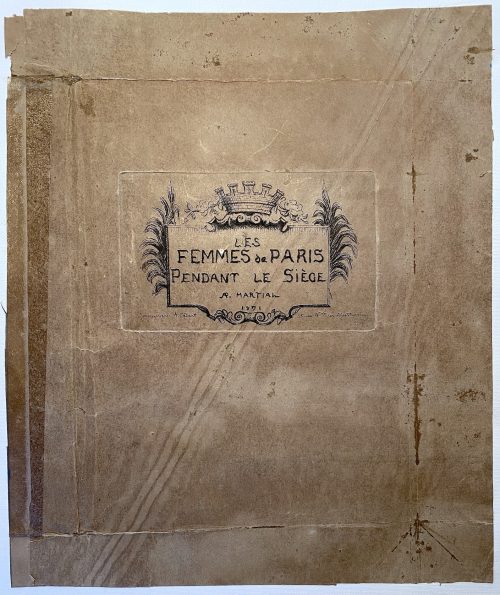 A suite of 12 etchings 160 x 118 mm each, in the first state, pasted on paper, 2 per sheet, with a cover (250 x 210 mm).0. Cover. Les femmes de Paris pendant le siège./R.Martial/1871.1. Lorsqu'à l'approche de l'ennemi on demandait l'éloignement des bouches inutiles [...] 2. L'Ennemi ! 3. No inscription 4. Quête pour les veuves. 5. Concert et quête pour les enfants blessés, malades, infirmes. 6. Au bastion/Et celles non moins précieuses qui dirigeaient ces ventes [...] 7. Vente pour les orphelins de la guerre. 8. No inscription 9. Une ration, bouillie romaine et Vin/Cantine municipale[...] 10. No inscription 11. No inscription 12. Les effets de cette union patriotique des femmes sont connus.[...]
A suite of 12 etchings 160 x 118 mm each, in the first state, pasted on paper, 2 per sheet, with a cover (250 x 210 mm).0. Cover. Les femmes de Paris pendant le siège./R.Martial/1871.1. Lorsqu'à l'approche de l'ennemi on demandait l'éloignement des bouches inutiles [...] 2. L'Ennemi ! 3. No inscription 4. Quête pour les veuves. 5. Concert et quête pour les enfants blessés, malades, infirmes. 6. Au bastion/Et celles non moins précieuses qui dirigeaient ces ventes [...] 7. Vente pour les orphelins de la guerre. 8. No inscription 9. Une ration, bouillie romaine et Vin/Cantine municipale[...] 10. No inscription 11. No inscription 12. Les effets de cette union patriotique des femmes sont connus.[...] -
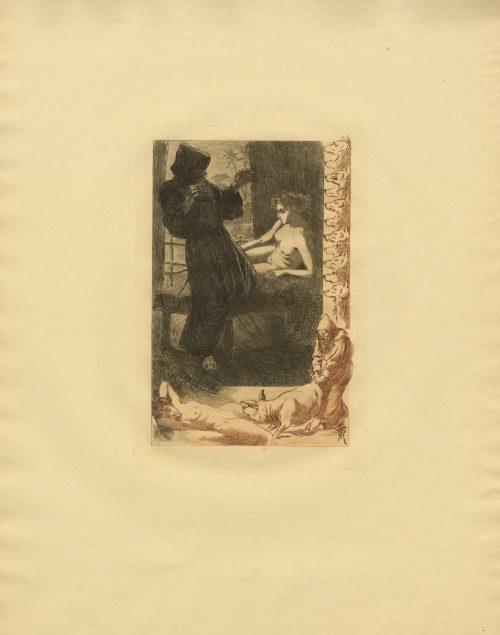 Set of 21 etchings by Martin van Maele for the English edition of ‘Thais’ by Anatole France published in London by Charles Carrington in 1901. Printed on vowe paper without a watermark in two colours with the black image and sepia historiated border. All etchings are inscribed with the artist's monogram; one of the etchings bears inscriptions ORGUEIL, LUXURE, DOUTE (mirror image). Dimensions: sheet: 317 x 250 mm; plate: 170 x 115 mm; image: 155 x 100 mm. Catalogue raisonné: S. A. Perry: № 64. Per Perry, the edition was printed in 500 copies on 'handmade paper watermarked 'Van Gelder'. Contributor: Martin van Maële [Martin, Maurice François Alfred] (French, 1863 – 1926)
Set of 21 etchings by Martin van Maele for the English edition of ‘Thais’ by Anatole France published in London by Charles Carrington in 1901. Printed on vowe paper without a watermark in two colours with the black image and sepia historiated border. All etchings are inscribed with the artist's monogram; one of the etchings bears inscriptions ORGUEIL, LUXURE, DOUTE (mirror image). Dimensions: sheet: 317 x 250 mm; plate: 170 x 115 mm; image: 155 x 100 mm. Catalogue raisonné: S. A. Perry: № 64. Per Perry, the edition was printed in 500 copies on 'handmade paper watermarked 'Van Gelder'. Contributor: Martin van Maële [Martin, Maurice François Alfred] (French, 1863 – 1926) -
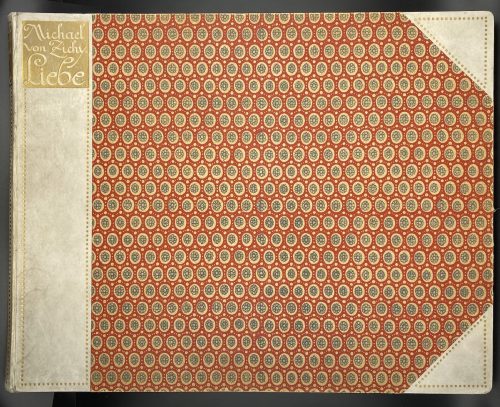 Oblong album of forty photogravures printed on wove paper in sanguine after drawings by Mihály Zichy; 31.5 x 40.5 cm gilt-decorated half-parchment over red boards with a gilt diaper design; embossed gilt label in the top left corner “Michael | von Zichy. | Liebe”. Anonymous edition. Bookplate to front pastedown: “P•U•H | EX | LIBRIS”. Photogravures made from the original watercolours and crayon drawings produced in 1874-1879; the original album consisted of 51 compositions was sold at Christie’s sale of Gérard Nordmann collection on December 14-15, 2006 in Paris. Some of these photogravures were reproduced photomechanically and printed in 1869 [LIB-2244.2019] and 1989 [LIB-2242.2019]. Limitation: 300 copies were privately printed in Leipzig in 1911 for subscribers only; photogravure copper plates were destroyed. This is copy № 285. Title-page (brown and black): MICHAEL VON ZICHY | LIEBE | VIERZIG ZEICHNUNGEN | PRIVATDRUCK LEIPZIG 1911 || Dimensions: album: 31.5 x 40.5 cm; sheets 31 x 40 cm, uncut. Catalogue raisonné: Bibliothèque érotique: Gérard Nordmann; Livres, manuscrits, dessins, photographies du XVIe au XXe siècle / Catalogues de ventes, seconde partie. — Paris: Christie’s, 2006; p. 280, № 564 (drawings); № 565 photogravures [LIB-2810.2021]. Contributors: Mihály Zichy [Michael von Zichy; Михаил Александрович Зичи] (Hungarian, 1827 – 1906).
Oblong album of forty photogravures printed on wove paper in sanguine after drawings by Mihály Zichy; 31.5 x 40.5 cm gilt-decorated half-parchment over red boards with a gilt diaper design; embossed gilt label in the top left corner “Michael | von Zichy. | Liebe”. Anonymous edition. Bookplate to front pastedown: “P•U•H | EX | LIBRIS”. Photogravures made from the original watercolours and crayon drawings produced in 1874-1879; the original album consisted of 51 compositions was sold at Christie’s sale of Gérard Nordmann collection on December 14-15, 2006 in Paris. Some of these photogravures were reproduced photomechanically and printed in 1869 [LIB-2244.2019] and 1989 [LIB-2242.2019]. Limitation: 300 copies were privately printed in Leipzig in 1911 for subscribers only; photogravure copper plates were destroyed. This is copy № 285. Title-page (brown and black): MICHAEL VON ZICHY | LIEBE | VIERZIG ZEICHNUNGEN | PRIVATDRUCK LEIPZIG 1911 || Dimensions: album: 31.5 x 40.5 cm; sheets 31 x 40 cm, uncut. Catalogue raisonné: Bibliothèque érotique: Gérard Nordmann; Livres, manuscrits, dessins, photographies du XVIe au XXe siècle / Catalogues de ventes, seconde partie. — Paris: Christie’s, 2006; p. 280, № 564 (drawings); № 565 photogravures [LIB-2810.2021]. Contributors: Mihály Zichy [Michael von Zichy; Михаил Александрович Зичи] (Hungarian, 1827 – 1906). -
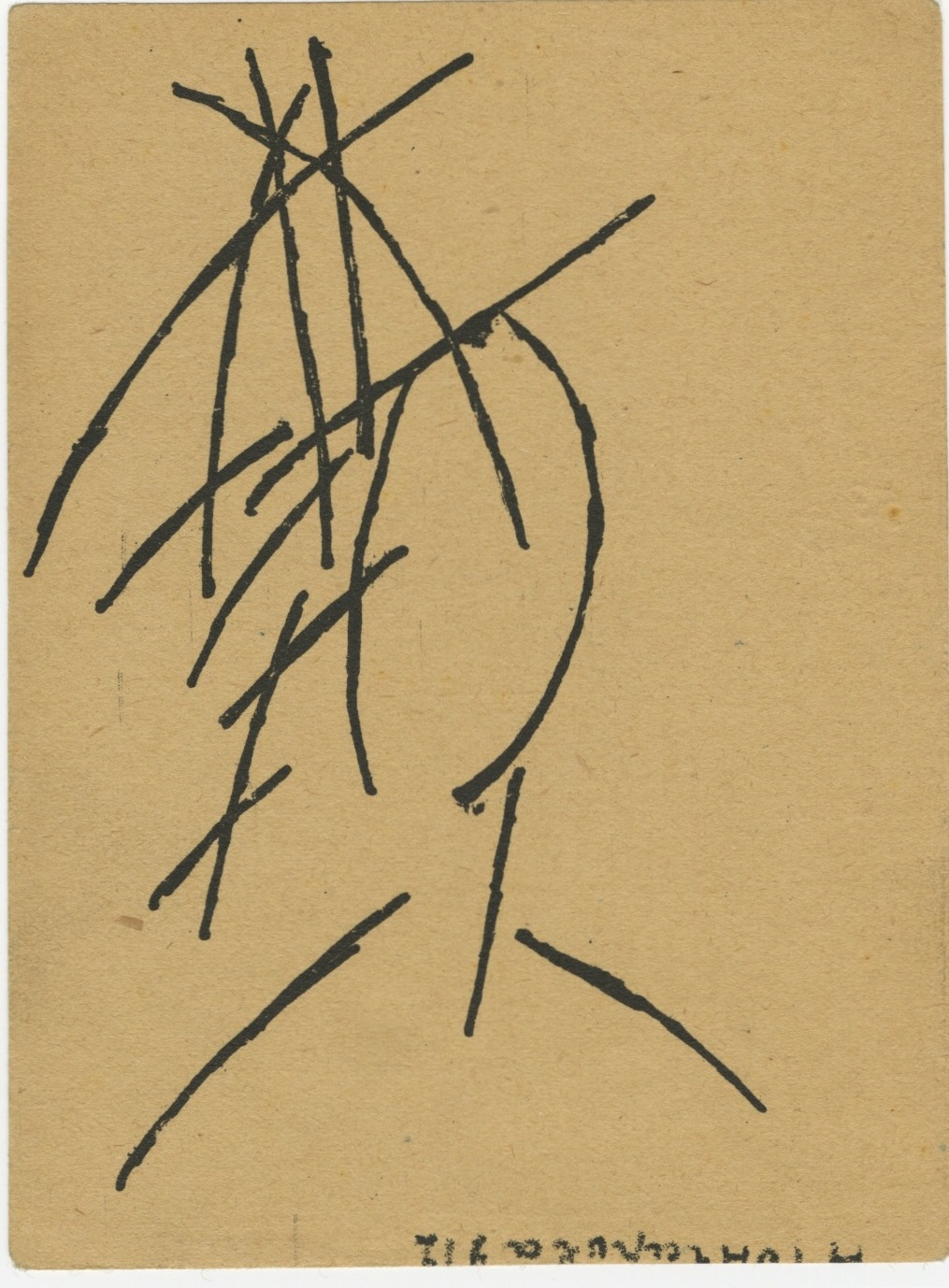 Artist: Mikhail Larionov (June 3, 1881 – May 10, 1964) ). Russian/French. Lithographic illustration "Woman in a hat" for Aleksei Kruchenykh book "Lipstick", Moscow, Kuzmin and Dolinsky Publishers, 1913, 480 copies printed. Size: 11,3 х 8,2 cm. Михаил Ларионов (3 июня 1881 – 10 мая 1964). Россия/Франция. Литографическая иллюстрация "Женщина в шляпе" к книге Алексея Крученых "Помада"; М.: Изд. Г.Л. Кузьмина и С.Д. Долинского, 1913, отпечатана в 480 экз. Формат: 11,3 х 8,2 см.
Artist: Mikhail Larionov (June 3, 1881 – May 10, 1964) ). Russian/French. Lithographic illustration "Woman in a hat" for Aleksei Kruchenykh book "Lipstick", Moscow, Kuzmin and Dolinsky Publishers, 1913, 480 copies printed. Size: 11,3 х 8,2 cm. Михаил Ларионов (3 июня 1881 – 10 мая 1964). Россия/Франция. Литографическая иллюстрация "Женщина в шляпе" к книге Алексея Крученых "Помада"; М.: Изд. Г.Л. Кузьмина и С.Д. Долинского, 1913, отпечатана в 480 экз. Формат: 11,3 х 8,2 см. -
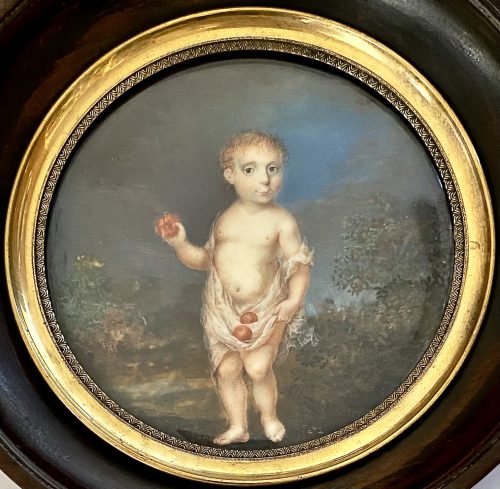 Round portrait of a little girl (22-month-old) with bright black eyes and red hair, draped in a semi-transparent shirt which leaves her chest and stomach bare, keeping a red apple in her right hand and two others lying in the fold of her clothes, standing against a dark natural background: bushes, leaves, an apple tree, blue skies, clouds, etc. Oil on metal; in an ormolu frame, in a wooden frame. Diameter without frames 8 cm, with frames – 12.6 cm. Sitter: Courtois, Fortunée-Florentine Elisabeth (French, August 23, 1800 г. – after 1878). Inscription (handwriting, nut ink): Fortunée, Florentine Elisabeth | Courtois a 22 mois. | née 5e fructidor an 8 || Attributed to Lié Louis Périn-Salbreux (French, 1753 – 1817). Fortunée-Florentine Elisabeth Courtois is a mother of Maurice Joly (French, 1829 – 1878). See also in this collection: blog, LIB-0460, blog, LIB-1038.2016, and Une Épave de l’Ancien Bateau by Tout-Paris. A Lost Article by Proust? The portrait was sold at Drouot (Paris) in 2020 with the following description: "École FRANÇAISE de la fin du XVIIIe siècle Fortunée Florentine Courtois enfant en chemise, en pied dans la nature, tenant trois pommes. Miniature sur ivoire, identifiée au revers : « Florentine Fortunée Elisabeth / Courtois à 22 mois / le 5e ( ?) Fructidor an VIII » [août 1800]; Diam. à vue : 7 cm; Cadre rond en bois tourné et noirci. Florentine Courtois, fille d’André et d’Elisabeth Corbara, épousa vers 1818 Lambert Philippe Joly, conseiller général du Jura, avocat ; leur fils Maurice Joly, avocat, fut ministre de la Justice du gouvernement provisoire en 1870 et grand maître du Grand Orient de France". Maurice Joly was a lawyer, but nothing else in his description given by Drouot is true. From this inscription, we learned that Fortunée-Florentine Elisabeth Courtois was born on August 23, 1800. We were unable to verify this from any other source. From Morice Joly autobiography (Maurice Joly, son passé, son programme par lui-même. — Paris, Lacroix, Verbœckoven et Ce, 1870) we know that she was born in Bastia and that her father, Laurent Courtois (in some sources André François Désiré Courtois, born c. 1771), was a treasurer of Corsican troops under Napoleon Bonapart. Her mother was Elisabeth Marie-Grâcieuse Corbara (born c. 1750).
Round portrait of a little girl (22-month-old) with bright black eyes and red hair, draped in a semi-transparent shirt which leaves her chest and stomach bare, keeping a red apple in her right hand and two others lying in the fold of her clothes, standing against a dark natural background: bushes, leaves, an apple tree, blue skies, clouds, etc. Oil on metal; in an ormolu frame, in a wooden frame. Diameter without frames 8 cm, with frames – 12.6 cm. Sitter: Courtois, Fortunée-Florentine Elisabeth (French, August 23, 1800 г. – after 1878). Inscription (handwriting, nut ink): Fortunée, Florentine Elisabeth | Courtois a 22 mois. | née 5e fructidor an 8 || Attributed to Lié Louis Périn-Salbreux (French, 1753 – 1817). Fortunée-Florentine Elisabeth Courtois is a mother of Maurice Joly (French, 1829 – 1878). See also in this collection: blog, LIB-0460, blog, LIB-1038.2016, and Une Épave de l’Ancien Bateau by Tout-Paris. A Lost Article by Proust? The portrait was sold at Drouot (Paris) in 2020 with the following description: "École FRANÇAISE de la fin du XVIIIe siècle Fortunée Florentine Courtois enfant en chemise, en pied dans la nature, tenant trois pommes. Miniature sur ivoire, identifiée au revers : « Florentine Fortunée Elisabeth / Courtois à 22 mois / le 5e ( ?) Fructidor an VIII » [août 1800]; Diam. à vue : 7 cm; Cadre rond en bois tourné et noirci. Florentine Courtois, fille d’André et d’Elisabeth Corbara, épousa vers 1818 Lambert Philippe Joly, conseiller général du Jura, avocat ; leur fils Maurice Joly, avocat, fut ministre de la Justice du gouvernement provisoire en 1870 et grand maître du Grand Orient de France". Maurice Joly was a lawyer, but nothing else in his description given by Drouot is true. From this inscription, we learned that Fortunée-Florentine Elisabeth Courtois was born on August 23, 1800. We were unable to verify this from any other source. From Morice Joly autobiography (Maurice Joly, son passé, son programme par lui-même. — Paris, Lacroix, Verbœckoven et Ce, 1870) we know that she was born in Bastia and that her father, Laurent Courtois (in some sources André François Désiré Courtois, born c. 1771), was a treasurer of Corsican troops under Napoleon Bonapart. Her mother was Elisabeth Marie-Grâcieuse Corbara (born c. 1750). -
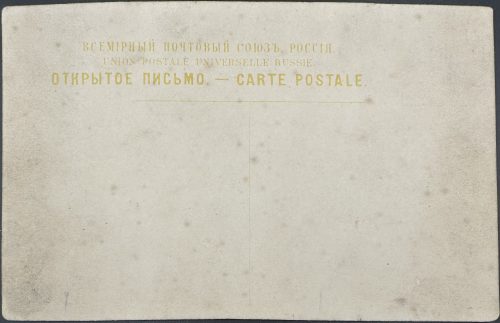 Ten postcards 90 x 140 mm, text in yellow "ВСЕМIРНЫЙ ПОЧТОВЫЙ СОЮЗЪ. РОССIЯ. | UNION POSTALE UNIVERSELLE RUSSIE. | ОТКРЫТОЕ ПИСЬМО. — CARTE POSTALE. || On the reverse, a blue ink woodcut image is printed in the upper left corner, and a идгу штл inscription is in the bottom centre. Holding the postcard against the backlight reveals a hidden image of an indecent nature (erotic). The use of Latin characters "R" and "N" instead of Russian "Р" and "Н" suggests that the cards were produced in Europe, probably in France. Inscriptions: 1. ПЕRВЫЕ ДNИ; 2. ПОRА ЛЮБВИ; 3. ВЪ ЛЮДИ; 4. КЪ "СВОБОДNОМУ ИСКУССТВУ"; 5. "СВОБОДNЫЙ ТRУДЪ; 6. БЕЗЪ ГОRЯ И ПЕЧАЛИ; 7. NАЗАДЪ КЪ "СВОБОДNОЙ ЛЮБВИ"; 8. ВСЕ ЧТО ОСТАЛОСЬ!; 9. БЕЗЪ КRОВА И ПRИСТАNИЩА; 10. ИЗЪ ЗА ХЛѢБА.
Ten postcards 90 x 140 mm, text in yellow "ВСЕМIРНЫЙ ПОЧТОВЫЙ СОЮЗЪ. РОССIЯ. | UNION POSTALE UNIVERSELLE RUSSIE. | ОТКРЫТОЕ ПИСЬМО. — CARTE POSTALE. || On the reverse, a blue ink woodcut image is printed in the upper left corner, and a идгу штл inscription is in the bottom centre. Holding the postcard against the backlight reveals a hidden image of an indecent nature (erotic). The use of Latin characters "R" and "N" instead of Russian "Р" and "Н" suggests that the cards were produced in Europe, probably in France. Inscriptions: 1. ПЕRВЫЕ ДNИ; 2. ПОRА ЛЮБВИ; 3. ВЪ ЛЮДИ; 4. КЪ "СВОБОДNОМУ ИСКУССТВУ"; 5. "СВОБОДNЫЙ ТRУДЪ; 6. БЕЗЪ ГОRЯ И ПЕЧАЛИ; 7. NАЗАДЪ КЪ "СВОБОДNОЙ ЛЮБВИ"; 8. ВСЕ ЧТО ОСТАЛОСЬ!; 9. БЕЗЪ КRОВА И ПRИСТАNИЩА; 10. ИЗЪ ЗА ХЛѢБА. -
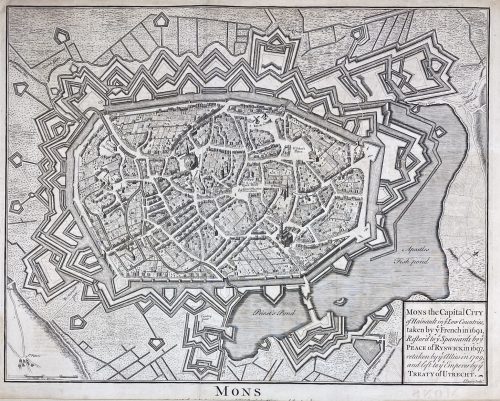
Mons the Capital City of Hainault in y Low Countries, taken by y French in 1691, Restor'd to y Spaniards by y Peace of Ryswick in 1697, retaken by y Allies in 1709, and left to y Emperor by y Treaty of Utrecht. attribution to publication source has been trimmed.
Dimensions: Sheet: 40.7 x 52.5 cm; Image: 37.5 x 48 cm. Published between 1744 and 1747. Attribution to publication source has been trimmed. Reference: Royal Academy 03/2919. Source: Maps for Mr. Tindal's Continuation of Mr. Rapin's History of England. London: John and Paul Knapton. Nicolas Tindal (British, 1687 – 1774) – the translator and continuer of the History of England by Paul de Rapin. Paul de Rapin (French, 1661 – 1725) – a Huguenot historian, author of the History of England.


